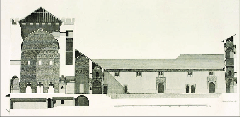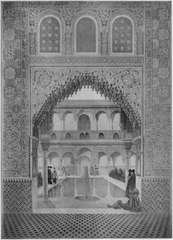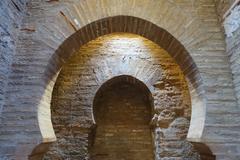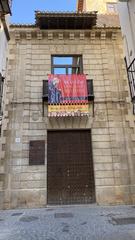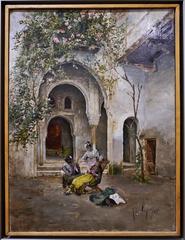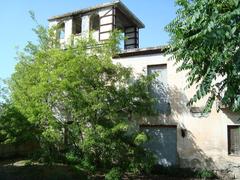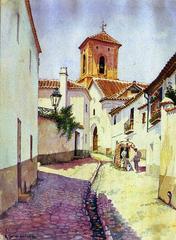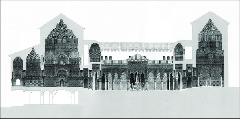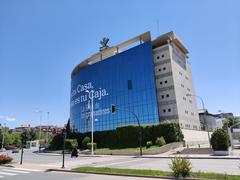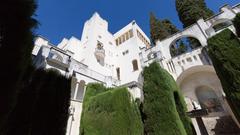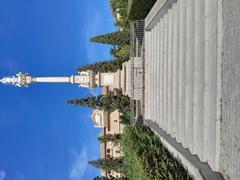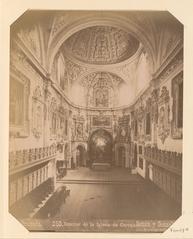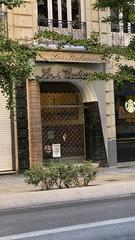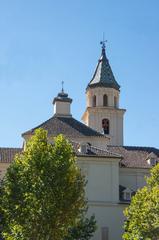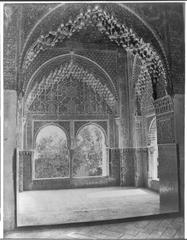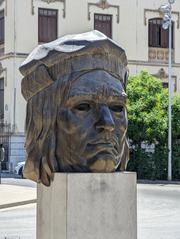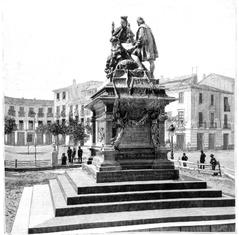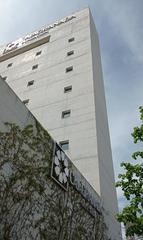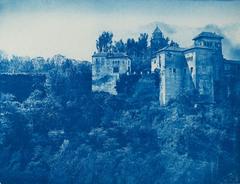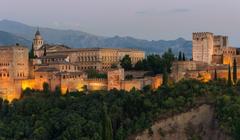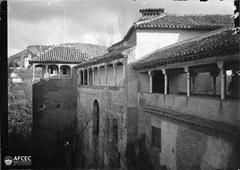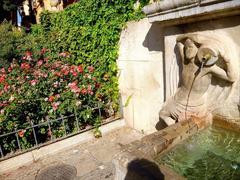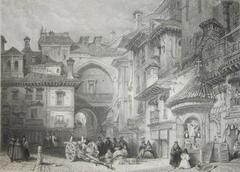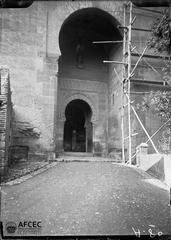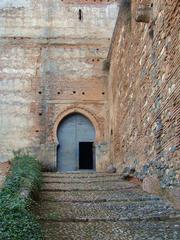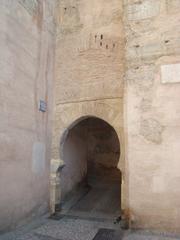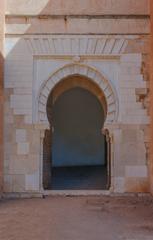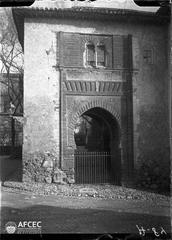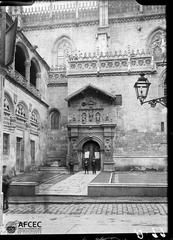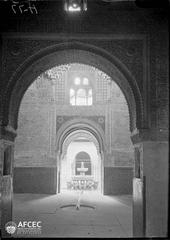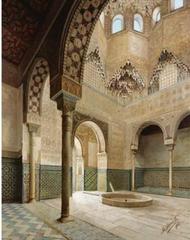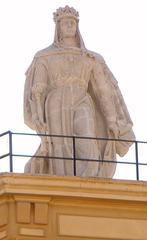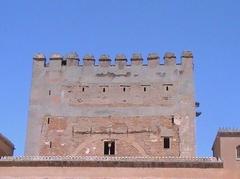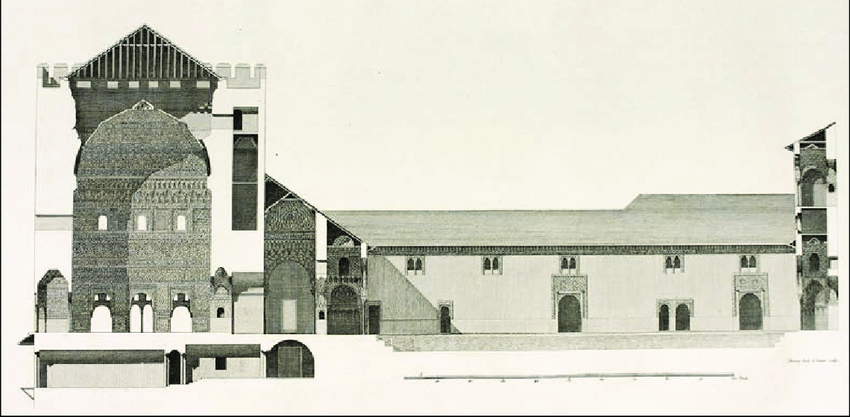
Sala de la Barca Visiting Hours, Tickets, and Complete Guide to Granada’s Alhambra
Date: 14/06/2025
Introduction
Nestled within the heart of Granada’s Alhambra, the Sala de la Barca stands as an enduring symbol of Nasrid artistry, spiritual symbolism, and royal ceremony. Located within the Palacio de Comares, this hall is celebrated for its intricate stucco work, calligraphic inscriptions, and a vaulted wooden ceiling that echoes the shape of an inverted boat hull. The name “Sala de la Barca” derives from the Arabic “al-baraka” (blessing), highlighting the chamber’s original role as a space for Nasrid sultans to spiritually prepare before entering the Hall of Ambassadors. This unique blend of art, architecture, and history makes the Sala de la Barca a must-visit for anyone exploring the Alhambra or seeking insight into Andalusian heritage.
This guide delivers all you need to know about the Sala de la Barca: its origins, architectural features, restoration history, visiting logistics, ticketing, accessibility, and nearby attractions. For official hours, ticket purchases, and the latest updates, use the Patronato de la Alhambra y Generalife website. Additional details and travel tips are available via Lonely Planet and Audiala.
Table of Contents
- Discovering the Sala de la Barca
- Origins and Historical Context
- Architectural Features & Artistic Significance
- Restoration and Conservation
- Planning Your Visit
- Practical Information & Etiquette
- Nearby Attractions
- FAQ
- Summary & Final Tips
- Sources
Discovering the Sala de la Barca
The Sala de la Barca (Hall of the Blessing) is one of the Alhambra’s most evocative chambers, notable for its serene atmosphere and exceptional Nasrid decoration. Historically, it served as a ceremonial antechamber—where Nasrid rulers paused for spiritual preparation, surrounded by poetic calligraphy and geometric design. For modern visitors, the space provides a window into the spiritual and political rituals of Granada’s last Muslim dynasty (Lonely Planet).
Origins and Historical Context
Commissioned during the reign of Yusuf I (1333–1354), the Sala de la Barca forms a critical transition between the Patio de los Arrayanes (Court of the Myrtles) and the Salón de los Embajadores (Hall of the Ambassadors). Its name, rooted in the Arabic “al-baraka,” signifies blessing—linking the space to both divine favor and the legitimacy of Nasrid rule.
Intricately inscribed walls and the orientation of the chamber emphasize its dual function as both a ceremonial and spiritual threshold—connecting the sultan’s private world with the public sphere of royal audiences (MDPI Sustainability Article).
Architectural Features & Artistic Significance
The Sala de la Barca exemplifies Nasrid architectural mastery, blending structural ingenuity with elaborate surface decoration:
- Layout: An elongated rectangular hall (24m x 4.35m x 8m) with carved arches connecting to adjacent palace spaces. Alcoves beside the entrance once held water jugs for ceremonial purification, and a small oratory adjoins the chamber for private prayer.
- Ceiling: The hall’s defining feature is its vaulted wooden ceiling, restored after a 19th-century fire. The ceiling’s form—like a boat hull—symbolizes safe passage and transition. Intricate geometric inlay work reflects the mathematical sophistication of Nasrid carpenters.
- Walls: Lower walls are lined with zellige (glazed ceramic tiles) in green, black, and white. Upper walls display elaborate plasterwork with Qur’anic verses, poetic inscriptions, and the Nasrid motto: “Only God is Victor” (ولا غالب إلا الله).
- Muqarnas: Pendentives (ornamental honeycomb vaulting) decorate the transitional zones, demonstrating both structural and decorative prowess (MDPI Sustainability, p.13).
Calligraphy & Ornamentation
Scriptural and poetic texts in Kufic and cursive styles reinforce the hall’s spiritual function. Vegetal and geometric motifs (ataurique and sebka patterns) evoke the infinite and unified nature of creation, a central theme in Islamic art.
Tilework & Ceiling
The azulejos (ceramic tiles) protect the walls and highlight the room’s connection to water—reflecting both aesthetic ideals and practical concerns. The ceiling, meticulously restored, preserves the illusion of an inverted ship, encapsulating the metaphorical journey from worldly concerns to the spiritual realm.
Restoration and Conservation
After a major fire in 1890 destroyed the original ceiling, the Sala de la Barca underwent several restoration campaigns. 19th-century documentation by Owen Jones and Jules Goury guided the reconstruction, while modern conservation employs advanced technologies such as laser scanning to monitor and preserve the hall’s features (MDPI Sustainability Article).
Planning Your Visit
Visiting Hours
- April–October: 8:30 AM – 8:00 PM
- November–March: 8:30 AM – 6:00 PM
- Night visits are sometimes available, offering a unique perspective.
- Always verify current hours on the official website.
Tickets & Prices
- General admission: ~€14 (includes Nasrid Palaces, Generalife, Alcazaba)
- Reduced/free tickets: Available for certain categories (children, residents, EU citizens—check official site)
- Booking: Strongly recommended to book online well in advance due to high demand.
Accessibility
- The Nasrid Palaces have made efforts to improve accessibility (ramps, smooth pathways), but some historic areas remain challenging. Contact visitor services for detailed information.
Guided Tours & Tips
- Guided tours (available in several languages) enrich your understanding and often provide skip-the-line access.
- Arrive 30 minutes early for your timed entry and bring your passport/ID.
- Non-flash photography is allowed; tripods/selfie sticks are not.
Practical Information & Etiquette
- Entry: Access to the Nasrid Palaces (including the Sala de la Barca) is by timed ticket only. No re-entry is permitted once you leave.
- Facilities: Restrooms are located near palace entrances; none within the Nasrid Palaces.
- Dining: Limited options on-site; eating inside the palaces is not allowed. Bring water, especially in summer.
- Comfort: Wear sturdy shoes and dress for the season.
- Behavior: Touching walls or tiles is prohibited to protect delicate surfaces; sitting is not allowed inside the palaces.
Nearby Attractions
Within the Alhambra
- Sala de los Abencerrajes: Octagonal stalactite ceiling and legendary Nasrid tales.
- Sala de los Reyes: Unique leather-lined and painted ceiling.
- Generalife Gardens: Iconic Nasrid gardens with panoramic views.
- Alcazaba: The fortress with sweeping vistas over Granada.
- Iglesia de Santa María de la Alhambra: Christian church built on the site of the former mosque.
In Granada
- Albaicín: Historic Moorish quarter with winding streets and the Mirador de San Nicolás.
- Cathedral and Royal Chapel: Key Renaissance monuments in the city center.
- The Bañuelo: Best-preserved Arab baths in Granada.
- Sacromonte: Flamenco, cave dwellings, and Romani heritage.
- Carrera del Darro & Paseo de los Tristes: Scenic riverside walks.
More details: (Audiala, Lonely Planet)
FAQ
What are the Sala de la Barca visiting hours?
It follows Alhambra opening times: typically 8:30 AM–8:00 PM (summer), 8:30 AM–6:00 PM (winter). Check the official website for updates.
How can I buy tickets?
Tickets (with timed entry) must be booked online and often sell out weeks ahead, especially for the Nasrid Palaces.
Is the Sala de la Barca accessible?
Efforts have been made, but some areas are challenging for wheelchairs. Consult visitor services for details.
Are guided tours available?
Yes—many companies and the Alhambra itself offer guided tours in multiple languages.
Can I take photographs?
Yes, without flash. Tripods and selfie sticks are not permitted.
What documents do I need?
Bring your ticket (physical or digital) and a valid passport or ID, as entry is strictly controlled.
What is the best time to visit?
Early mornings or late afternoons have fewer crowds and softer light for photos.
Summary & Final Tips
The Sala de la Barca encapsulates the essence of Nasrid Granada: spiritual symbolism, architectural innovation, and artistic beauty. To make the most of your visit:
- Book tickets well in advance, especially in high season.
- Arrive early for quieter moments and better photos.
- Consider a guided tour for deeper insight.
- Explore nearby attractions both within the Alhambra complex and in Granada city.
- Download the Audiala app for offline guides and the latest news.
- Check official sources for current hours and accessibility updates (Patronato de la Alhambra y Generalife).
By preparing carefully, you’ll be able to fully appreciate the Sala de la Barca’s history, symbolism, and artistry—making it a highlight of your Granada journey (Audiala, Lonely Planet).
Sources
- Patronato de la Alhambra y Generalife Official Site
- Lonely Planet: Sala de la Barca
- MDPI Sustainability Article on Alhambra Restoration
- Audiala: Alhambra and Sala de la Barca Guide
- Andalucia360 Travel: Tiles of the Alhambra
- earthtrekkers.com Alhambra Guide
- culturedvoyages.com Alhambra Tips
- notjustatourist.com Granada Travel Tips
- planetware.com Granada Attractions
- lovegranada.com Granada What to See
